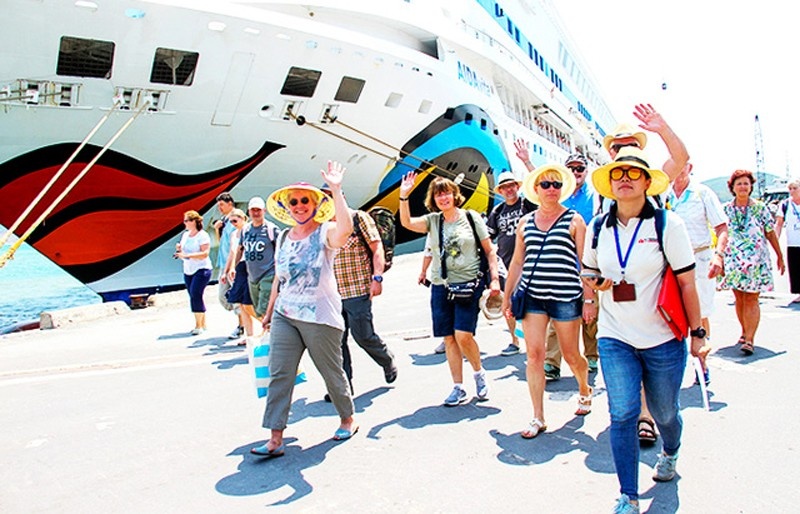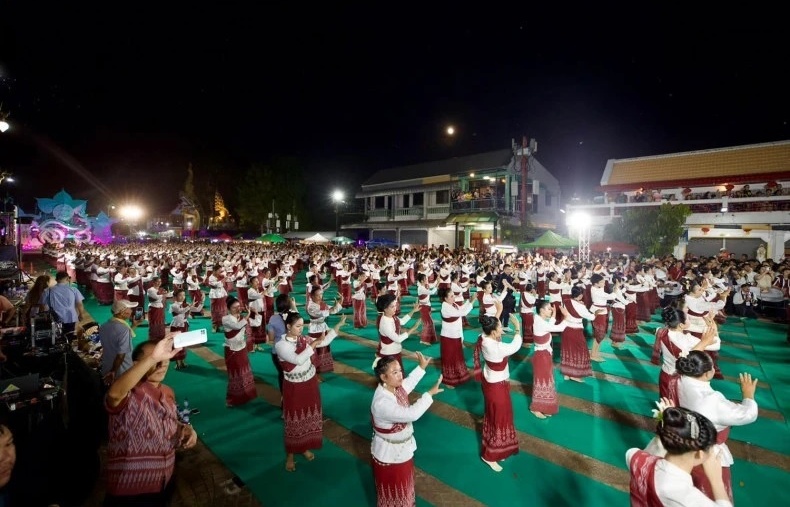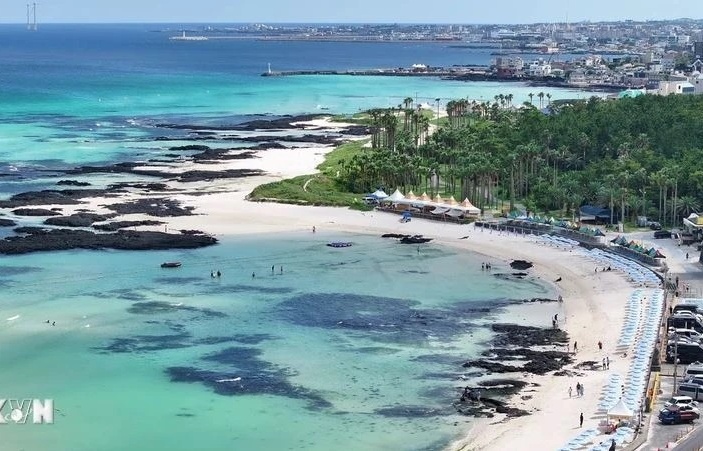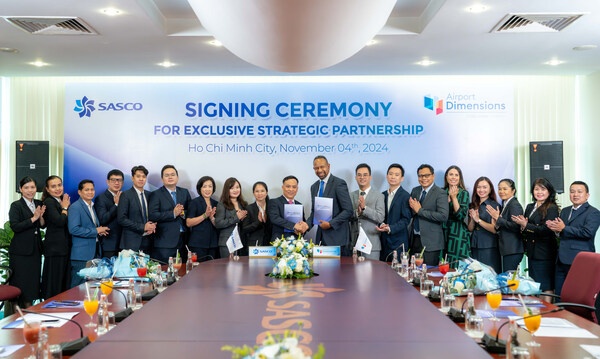Airlines raise Vietnam tourism on global stage
 |
The December revelation of co-operation between Thien Minh Travel JSC CEO Tran Trong Kien, and AirAsia Group counterpart Tony Fernandes, to develop in the Vietnamese market caused quite a stir among investors and brought joy to many Vietnamese people. Thien Minh Group has already strongly invested in the aviation sector since 2014, although its last dip into Vietnam failed to materialise. Meanwhile, Malaysian-based AirAsia has three times previously attempted to penetrate the Vietnamese market, notably with the signing of an unsuccessful strategic partnership with budget carrier Vietjet eight years ago.
But these blips did not force the two CEOs out of the game. While Kien shared that every experience is special and gives him motivation to try new things, Fernandes asserted that Vietnam is the latest country to lure AirAsia, where this brand operates through a joint venture in low-cost aviation. “If AirAsia wants to be a true airline of Southeast Asia, we must affirm our presence in Vietnam,” Fernandes told the Vietnam Travel and Tourism Summit 2018.
This return of AirAsia is demonstrating the open-sky policy of Vietnam after the country decided to allow 71 foreign airlines from 28 countries and territories to operate in the domestic market. In mid-2018, the Vietnamese aviation industry also recognised the appearance of a new private airline owned by FLC Group, Bamboo Airways.
Together with four other airlines currently operating, namely Vietnam Airlines, Vietjet, Jetstar Pacific Airlines and VASCO, Bamboo Airways aims to provide customers with access to high-quality, affordable aviation services with flights to FLC resort-based destinations in Quy Nhon, Quang Ninh, Quang Binh, and Thanh Hoa.
Dang Tat Thang, deputy general director of FLC Group and CEO of Bamboo Airways, said that by 2023 the company will operate over 24 domestic flights and 16 international flights connecting Vietnam with Asian countries such as South Korea and Japan.
The positive change in Vietnam’s aviation industry is also reflected in the emergence of Van Don International Airport in the northern province of Quang Ninh, the first airport in Vietnam to be developed by the private sector.
The Vietnamese aviation market is also serving 71.4 million passengers, an increase of 15 per cent compared to 2017. These impressive results have set the path for promoting the Vietnamese tourism industry to develop strongly in the past year, with aviation and tourism being two closely-interconnected economic sectors. Accordingly, 70-80 per cent of passengers transit by plane with the purpose of travel and the number of tourists to Vietnam by air also accounts for a similar proportion, according to statistics from the Vietnam National Administration of Tourism.
In comparison, in Thailand, the tourism powerhouse of Southeast Asia, the aviation industry has developed strongly with more than 30 airports operating regularly, with over 10 international airports and 15 domestic airlines. Thanks to the diversification of flight routes, flight frequency and cost reduction, Thailand’s aviation has become one of the important factors to help the tourism industry grow. In 2017, the country welcomed 34 million international tourists and more than 50 million domestic tourists with a total revenue of $74 billion. Thailand is investing tens of billions of dollars to upgrade existing airports and open new ones, enabling airlines to operate smoothly and more easily.
 |
| Changes in the aviation industry reflect growth in the tourism sector |
Vietnam’s tourism is empowered
The development of the aviation market has boosted growth of Vietnam’s tourism industry. Data from the International Air Transport Association shows that Vietnam was the world’s seventh-fastest growing aviation market in the 2013-2017 period, and will become one of the five fastest-growing markets globally in terms of additional passengers annually by 2035. The Civil Aviation Administration of Vietnam forecasts that the number of air passengers may reach 142 million by 2020, which means on average a growth rate of 14 per cent during 2017-2020.
Recognising the positive effects generated by the aviation market, some Vietnamese tourism enterprises have combined with domestic and international airlines to open more charter flights to attractive tourist destinations in Vietnam as well as bringing local tourists to famous tourist destinations across the world. Serving the transportation demand of customers, some major travel companies such as Vietravel, Saigontourist, Ben Thanh Tourist, Vietnam Travel, and TransViet have co-operated with carriers and localities to organise charter flights. Many localities, including Can Tho, Quang Binh, and Nghe An, are willing to support and even compensate losses for carriers, and offer tour operators charter flights aiming to lure more tourists.
Vietnamese airlines are also enthusiastic to enter the business through the lease of aircrafts and offering attractive incentives for tour operators. Tours using air charters are flourishing, and low-cost carrier Vietjet is taking advantage of this opportunity. The revenue of Vietjet from leasing air charters has sharply surged from VND412 billion ($17.9 million) in 2014 to VND2.63 trillion ($114.4 million) in 2016. On average, one in every four flights is by charter.
At the beginning of 2016, Vietnam Airlines had leased three Airbus A350 aircrafts that were handed over in the 2016-2017 period. According to the information from Jetstar, the rent of charter flights is quite modest on the domestic routes, but much more on foreign routes.
The introduction of charter flights brings a large number of visitors to the country, especially major domestic tourist cities. The flight from Danang has connected with 20 destinations worldwide, including 14 charter flights to the largest cities in China. Nha Trang also attracts foreign visitors thanks to charter flights, most of whom are Russian and Chinese. In addition, other routes have been evaluated with the launch of flights such as Can Tho, Dalat, Danang and Hue to Bangkok, and together with some routes to China and Russia, which have been successful in numbers of guests.
According to the Vietnam National Administration of Tourism, the country welcomed 15.6 million international visitors and 80 million domestic tourists across 2018, with the total tourism revenue of VND620 trillion ($27 billion). The total number of international arrivals to Vietnam has doubled over the last three years. Vietnam is ranked sixth among the world’s 10 fastest-growing travel destinations by the United Nations World Tourism Organization, and is also honoured as one of the world’s top destinations. This is the premise for the Vietnamese tourism to reach the goal of luring 18 million international tourists, welcoming and serving 85 million domestic tourists, and achieving the total revenue of over VND700 trillion ($30.4 billion) from tourism in 2019.
| Duong Tri Thanh, CEO Vietnam Airlines
The year 2018 was one of fluctuation with the unstable changes in fuel prices. The situation caused direct and adverse impacts on the aviation industry in Vietnam and worldwide as well. During the period of October and November, the rise of fuel prices had bad effects on all activities of the industry. However, for Vietnam Airlines, this was a successful year. In 2018, we fully had 142,000 flights and served 22 million passengers. Remarkably, Vietnam Airlines reached a significant milestone with profits exceeding VND2 trillion ($87 million) for the first time. During the year, we focused on training and educating to obtain the highest quality human resources as well as upgrading quality of services, especially ensuring flights run on time. The 2018 successes create an important background for further growth in 2019. Dang Tat Thang, CEO Bamboo Airways
Bamboo Airways aims to become an airline that offers high-end services at reasonable prices. We are creating more services and products for customers when we fill in areas where traditional aviation has not focused on, and access the segment where low-cost aviation has not yet become interested in. In the short-term, Bamboo Airways will focus on routes connecting Northeast Asian territories, such as Japan, Korea, China, Singapore, Thailand, Hong Kong, Taiwan, and the Philippines to destinations in Vietnam such as Quy Nhon, Quang Ninh, Haiphong, Thanh Hoa, Phu Quoc, and Nha Trang. In the long-term, the carrier will launch more flights to the US and Europe. Tony Fernandes, CEO AirAsia
We’re an Asian brand. We are in Malaysia, the Philippines, Indonesia, and Thailand. Vietnam is the last big Asian country that we are not in as a local company. The potential is very large for Vietnamese tourism. There is no reason why Vietnam can’t become as strong as Thailand. We can do routes from small cities, for example in Malaysia, Thailand, from Chiang mai, Phuket,… So we can do a lot more destinations and routes that enter into Vietnam. We hope by July 2019, we can start AirAsia Vietnam, which would be a big dream for me. I’ll bring all the Vietnamese to Malaysia and I’ll take all the Malaysian to Hanoi. We are truly Asian. Luong Hoai Nam, Deputy general director Vietstar Airlines
The strong development of aviation in Vietnam from the 90s to the present is an important factor promoting Vietnam’s tourism development. However, we are lagging behind in both means of flying vehicles and infrastructure at airports, having bottleneck with the sky management mechanism and pilot licences. There is a shortage of large capacity airports. 21 airports in the country which currently have a combined capacity of serving 75 million passengers per year, equal to just one airport in Singapore, Thailand or Malaysia. Tan Son Nhat International Airport is overloaded while expansion is delayed. Competition in the aviation industry is minimal, with few airlines participating. In order to remove this bottleneck, we should facilitate the establishment and operation of air transport, grant domestic and international business rights and ease foreign investment in aviation. |
What the stars mean:
★ Poor ★ ★ Promising ★★★ Good ★★★★ Very good ★★★★★ Exceptional
Related Contents
Latest News
More News
- Ba Ria-Vung Tau strengthens regional links to bolster tourism (November 04, 2024 | 10:00)
- Vietnam attracts growing interest from global travellers (October 28, 2024 | 17:59)
- Vietjet receives latest aircraft from Airbus in France (October 08, 2024 | 18:02)
- Telling travel stories through movies (October 08, 2024 | 14:00)
- South Korean tourists lead Vietnam’s tourism revival (October 08, 2024 | 11:49)
- Vietnam a golden land for golf tourism (October 08, 2024 | 11:41)
- Con Dao leads the way in circular tourism (October 08, 2024 | 08:00)
- Nestlé and VNAT announce new cooperation initiative (October 02, 2024 | 15:43)
- Hanoi recognises new city-level tourist areas (September 27, 2024 | 20:25)
- Hue to host 2025 National Tourism Year (September 19, 2024 | 15:13)








 Tag:
Tag:















 Mobile Version
Mobile Version